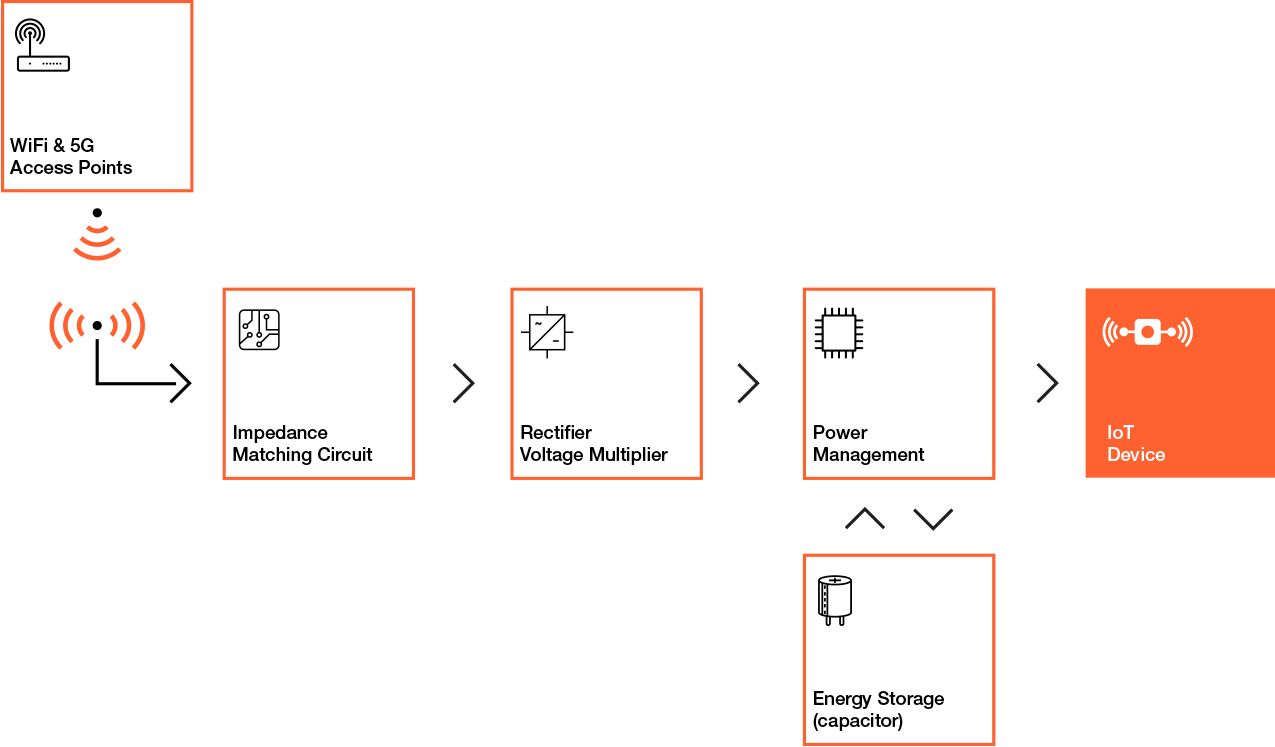How do RF ambient energy harvesters work?


Because of rapidly growing wireless communication and radio sensing applications, the radio frequency spectrum has already been saturated, even congested in most areas of the world. Especially in urban and semi-urban areas, digital TV (DVB-T, Digital Video Broadcasting - Terrestrial), 3G, 4G, 5G, WiFi, signals are simply ubiquitous. Although this situation is expected to cause major challenges for future communication and sensing networks by triggering complicated resource and frequency allocation problems, these radio waves surrounding us also provide significant opportunities for energy harvesting to power Internet of Things (IoT) nodes or ultra-low-power batteryless devices.
How does it work?
Ambient RF energy is harvested by firstly collecting the surrounding RF waves via highly efficient and high-gain antennas and then converting them into DC voltage via rectifier circuits. Therefore, RF energy harvesters are also called rectennas (rectifying antenna). Subsequently, the harvested DC energy needs to be stored in low-loss capacitors or batteries until it is consumed by electronic components such as IoT nodes, sensors or microcontrollers. It is evident that the efficiency of antennas, rectification circuits and power storage components remarkably affect the amount of energy harvested and transferred to the IoT node.

IoT nodes tend to be really small - Therefore, all of these other components also need to be of a suitably small size. They need to be as tiny as possible so that they fit neatly into these small devices. Owing to the significant advantages and ubiquitous availability of RF signals, ambient RF energy harvesting has recently received a lot of attention from top researchers and companies from around the world. There are already a significant number of published studies from theory to implementation and measurements.
Let us take a brief look at some of the major studies showing the opportunities and challenges of ambient RF energy harvesting.
What are the Available RF Sources for Harvesting ?
A study conducted by researchers from the Imperial College London in 2013 performed city-wide radio frequency (RF) measurements in London to identify possible RF sources for opportunistic RF energy harvesting. They found that DVB-T signals at 500 MHz, GSM900 at 900 MHz, GSM1800 at 1800 MHz, 3G signals at 2.2 GHz and WiFi signals at 2.4 GHz spectrums may have sufficient power radiated for RF energy harvesting.
It is important to note that since then, 4G and 5G networks and new spectrums for mobile and WiFi communication networks have been introduced and already utilized.Therefore, there are more RF resources that can be considered for harvesting. They achieved 40% efficiency in energy harvesting and showed that the harvested energy is comparable to energy harvested by alternative ambient energy harvesting technologies such as human vibration and temperature. Considering that urban and semi-urban areas are well covered by DVB-T or mobile networks, it is always possible to harvest and store sufficient energy to power low-power IoT devices.
Furthermore, multiple RF energy sources can be targeted for energy harvesting by employing wideband or multiband antennas to maximize the amount of energy harvested. Another study conducted in Tokyo in 2013 demonstrated that it is possible to power up a standard microcontroller (MCU) via the energy harvested from a DVB-T tower located 6.3 km away from the harvester. They achieved around 22% efficiency which can be further improved by a cutting-edge high-efficiency antenna and rectifier design. They considered a standard 16-bit microcontroller which is indeed power-hungry compared to modern IoT MCUs, such as ONiO.zero which efficiently performs tasks and cleverly utilizes the available energy by adjusting its clock frequency.
How Much Energy can be Harvested ?
More recent studies also considered 4G and 5G communication spectrums for RF energy harvester (rectenna) design. A multiband slotted bow-tie antenna operating at 840 MHz, 1.86 GHz, 2.1 GHz and 2.45 GHz bands with an integrated multiband rectifier was designed, fabricated and tested in a study, where the researchers achieved around 30% efficiency. This is a promising result for future energy harvesting applications. Furthermore, researchers from the Hong Kong University of Science and Technology aimed to maximize the DC output power of a rectenna by employing multiple antennas. To this end, they designed a 0.3λ×0.3λ (λ:wavelength) antenna with a gain of 5.5 dBi and utilized 4 of this antenna for collecting RF waves. By doing so, they were able to harvest energy by up to 6 times more than a single antenna. The harvested and stored DC energy was around 11.2 μW which is significantly high compared to a single antenna system. A dual-band rectifier was designed in another study.
Not only communication networks but also other RF resources can be exploited for ambient energy harvesting. For instance, the RFID spectrum was considered in a recent study published in Nature Scientific Reports. A small and efficient rectenna was developed operating at 868 MHz (RFID band in Europe), that can harvest sufficient energy for batteryless wireless sensor networks nodes. This rectenna was demonstrated to deliver 172 μW at 2.85 V every 22.5 s, which is more than enough for most sensing applications. In addition to storing the energy harvested, it is also vital to intelligently manage the energy consumption of the IoT nodes or MCUs. For example, modern low-power IoT MCUs support sleep-awake modes to reduce the power consumption such that they can switch into the ultra-low-power sleep mode when they do not need to perform any tasks.
Innovative Materials for RF Energy Harvesting
Last but not the least, various materials and structures have recently been considered for developing and implementing efficient and small rectennas. For example, metasurface structures are considered for antennas to develop small size, highly efficient rectennas. Another example, Graphene, which is one of the recently discovered materials, has been recently researched for electromagnetic applications from microwave to THz applications.
Graphene has also been considered for RF energy harvesting, especially to develop flexible rectennas for ultra-low power sensors and applications in a study. Graphene has a unique structure consisting of a single layer of carbon atoms engineered to create a two-dimensional honeycomb mesh and it has outstanding electromagnetic and physical features. Since carbon is available everywhere, graphene can reduce the cost of electronic devices. Moreover, graphene can easily be used even on paper or textile products to fabricate antennas and circuits.
A study from a collaboration between universities from the USA, the UK and China focused on developing laser-fabricated bio-integrated, stretchable and flexible antennas and rectennas fabricated on elastomeric substrates for self-powered systems, remote monitoring of the human body or environment. Such flexible technologies can also include electronic circuits and embedded sensors to maximize efficiency and minimize the size of the energy harvester. Flexible rectennas and circuits are valuable especially for on-body sensors to enhance the user experience while performing their functions.
Challenges and Future of RF Energy Harvesting
Developing highly efficient and small size (miniaturized) wideband or multiband antennas that can fit into an IoT node or a sensor remains the biggest challenge with ambient RF energy harvesting technologies for IoT devices.
Therefore innovative and out-of-the-box approaches for antenna design are required to achieve high efficiency within the size constraints of such devices. The rectifiers can be designed and implemented on-chip to minimize the transmission losses and maximize their conversion efficiency while reducing their size.
Consequently, It is highly possible to achieve much better energy efficiency and longer batteryless operation times by optimizing the antennas and rectifiers while carefully managing the energy consumption of the devices. It is envisaged that the future of wireless sensor networks (WSN), Internet of Things (IoT) or ultra-low-power communication and sensing applications will remarkably embrace RF ambient energy harvesting technologies and opportunities.












